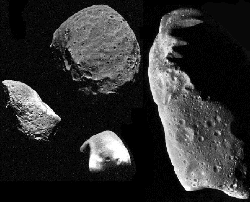Within the complex of asteroids orbiting the sun is a group of asteroids whose orbits cross the path of the earth's movement around the sun. Their perihelion is significantly closer to the Sun. The most prominent in this group are Python and Icarus

Within the complex of asteroids orbiting the sun is a group of asteroids whose orbits cross the orbit of the Earth around the sun. Their perihelion is significantly closer to the Sun. They are closer to her than Mercury. The most prominent among them are Phaeton and Icarus. Phaeton's endpoints are 2.403-0.14 AU and 3 km in diameter.
The endpoints of Icarus are 1.969-0.187 AU and its diameter is 700 meters. Based on the shape of the asteroids that have been photographed so far, whether they are spacecraft or radar images from the Earth, it seems that they are not spherical bodies but fragments of rocks. They originate from larger bodies that broke as a result of collisions with other bodies and whose parts moved in all directions. Some of them entered orbit around the sun. It is therefore reasonable to assume that there are other asteroids whose perihelion points are similar to those of Phaeton and Icarus and due to their tiny dimensions have not yet been discovered.
Due to their large eccentricity, it is clear that as they approach the sun the temperature of the surface increases and as they move away from the sun the temperature decreases. Near them to the sun the surface temperatures can reach hundreds of degrees Celsius and a good indication of this is Mercury whose distance from the sun is 0.38 astronomical units and during its daytime the temperature in the illuminated area is 400 C. With the breakup of the large bodies, their internal parts are exposed to space and most likely also contain various gases, gases that were a product of ancient geological processes. Therefore, as these asteroids approach the Sun, the surface becomes warmer and these gases also heat up and evaporate from the surface. As the amount of trapped gases was greater in the source body, a greater number of perihelions were required for these materials to evaporate. The amount of gas depends equally on the size of the asteroid. A small asteroid with a diameter of, for example, hundreds of meters can have a small amount of gas, and a large asteroid with a diameter of several kilometers can have a larger amount of gas. For comparison, Comet Borrelly photographed in 2001 by the Deep Space 1 spacecraft is 5 km long and during the perihelion ejected material weighing 2 tons. At the same time, an important geological constraint must be taken into account, which is the location of the rock block in the body of the source from which it was torn. It is possible that this body was originally a planet or a large asteroid with a bookish structure where there was volcanic activity at the site of the rupture and where there are large amounts of gases characteristic of volcanoes and therefore it would also require a large number of perihelions of an asteroid moving very close to the sun to evaporate all the gases. It is not impossible that these asteroids also have a trail similar to the trails of comets, albeit shorter.
These asteroids, like other asteroids, rotate around their axis, a phenomenon also observed in Halley's and Borrelly's comets. Since these are not spherical bodies, the three axes are different from each other in length and it is impossible to know which axis they revolve around. If the places from which the gases are emitted are in different places on their surface, there can be a situation in which the emission of the gases is cyclical as a function of their axial rotation speed. If the rotation speed is high, they are exposed more quickly to sunlight and gas emissions occur. However, from the moment this surface is away from the sun, i.e. dark, the emission of gases stops until the surface is exposed to the sun again. On the other hand, there can be a situation in which the asteroid rolls on its trajectory, one side of the asteroid is exposed to the sun for one half of the time it orbits and for the other half the other side of the asteroid is exposed to the sun. In any case, as long as one side is exposed to the sun, gas emission occurs, but it increases as the asteroid approaches the perihelion and weakens as it approaches the aphelion.
A more in-depth study of these asteroids will be possible in the future when spacecraft will be landed on them to carry out long-term studies. At the same time, there is another and more complex option that will require the presence of astronauts for short periods of time and they will perform a number of preparatory actions on them for continuous and unmanned research. These operations include digging deep shafts to bury explosives, digging shafts to fix rocket engines and placing research instruments, and when these operations are finished, the astronauts evacuate the site and remotely activate the explosives. The result that will be obtained is that some of the asteroid fragments will enter orbit around the sun, an entry that will be carried out using the rocket engines. From the moment they are placed in their orbits, the research instruments will be activated. In this operation, comet-like asteroids and possibly comets are created artificially. It seems that this way will yield more scientific fruits than the casual investigation of comets by means of spectroscopy from the Earth or satellites orbiting it.
https://www.hayadan.org.il/BuildaGate4/general2/data_card.php?Cat=~~~328022569~~~98&SiteName=hayadan
